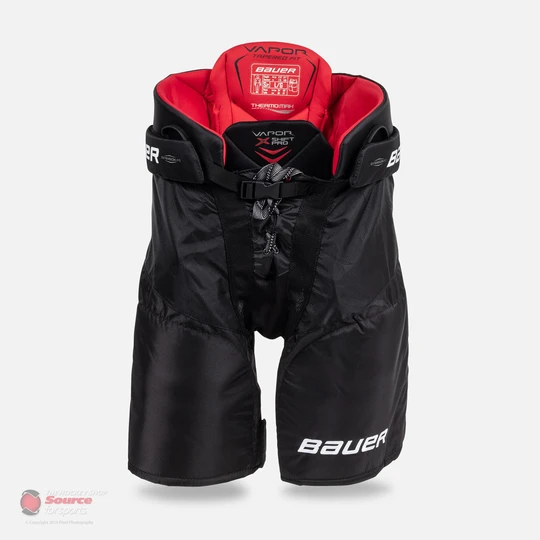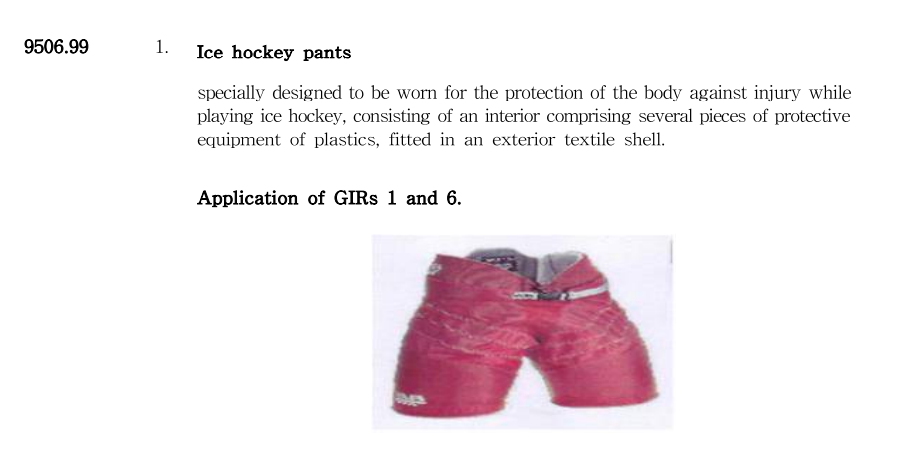Hockey pants classified as “Garment”(HS:6211.33) or “Sports equipment”(HS:9506.99)?
This article is regarding the court case of classification of Hockey pants.
The issue is about Mutually exclusive exclusionary notes.

Source:thehockeyshop.com
US Customs classified it as “Garment”(HS:6211.33)
6211
Track suits, ski-suits and swimwear; other garments:
* * *
6211.33.00
Of man-made fibers.
Bauer contends that it’s classifiable as “Sports equipment”(HS:9506.99)
9506
Articles and equipment for general physical exercise, gymnastics, athletics, other sports
(including table-tennis) or outdoor games, not specified or included elsewhere in this chapter;
swimming pools and wading pools; parts and accessories thereof
* * *
9506.99
Other
Table of Contents
1.Customs’s opinion
Note 1(e) to Chapter 95 exclude items classified in Chapter 95.
1.- This Chapter does not cover :
(e) … sports clothing and special articles of apparel of textiles, of Chapter 61 or 62, whether or not incorporating incidentally protective components such as pads or padding in the elbow, knee or groin areas (for example, fencing clothing or soccer goalkeeper jerseys);
Source: WCO
Therefore it can not be classified in 9506
2.Plaintiff’s opinion
Note 1(t) to Section XI exclude items classified in Chapter 95.
1.- This Section does not cover :
(t)Articles of Chapter 95 (for example, toys, games, sports requisites and nets);
Source: WCO
Therefore it can not be classified in 6211
3.Court Opinion
Assuming the subject merchandise is prima facie classifiable under both Chapters 62 and 95, each chapter has associated with it an exclusionary note that would ordinarily preclude classification of the subject merchandise under the competing chapter.
See Note 1(t) to Section XI (excluding from this section, including Chapter 62, articles of Chapter 95); Note 1(e) to Chapter 95 (excluding “sports clothing . . . of textiles, of chapter 61 or 62”).
Under such circumstances, we must evaluate which heading, and if necessary, subheading, provides the more specific description of the merchandise before we examine the exclusionary notes associated with the applicable classification.
See Sharp Microelectronics Tech., Inc. v. United States, 122 F.3d 1446, 1450-51 (Fed. Cir. 1997) (noting that exclusionary notes play a complementary role to the rule of relative specificity and finding it improper to rely on an exclusionary section note before applying the rule of relative specificity between competing headings).
Resorting to the exclusionary note before applying the rule of specificity, as Customs did in its classification ruling, would yield the somewhat arbitrary result that the subject merchandise could be classified under different chapters based solely on which chapter the analysis began.
For instance, if Customs had started with Chapter 95 instead of 62 and properly concluded that the merchandise is classifiable as sports equipment, it would have arrived at a conclusion opposite to that reached in its original ruling, and found the hockey pants classifiable only under Chapter 95.
CONCLUSION
For the foregoing reasons, we reverse the decision of the Court of International Trade affirming Customs’ classification and hold that Bauer’s subject merchandise must be classified under subheading 9506.99.25.
It’s called “Mutually exclusive exclusionary notes”
Under such circumstances, we can not decide which exclusionary notes should be applied.
In this case, the court applied the relative specificity analysis under GRI 3(a) to resolve this classification dispute.
Source:casetext
A similar case is stated in WCO’s Compendium of Classification Opinion

